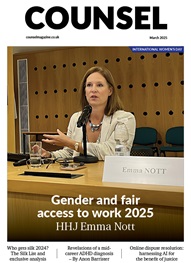*/
Adrian Eissa and Ruth Barber
ISBN: 978 1 84766 707 6. September 2011
Publisher: Bloomsbury Professional. Price: £75
Even barristers of the very near future will look back with astonishment that their predecessors were still, in the 21st century, laden with kilos of textbooks as they set off for court in the morning. Any exceptionally diligent criminal practitioner embarking for a confiscation hearing faces the Herculean prospect of dragging Archbold 2012 with supplement and Mitchell, Taylor and Talbot on Confiscation and Proceeds of Crime behind them. Punishment not just for the muscles but also for the bank balance with RRPs of £455 and £342 respectively.
Of course the advent of e-Archbold is upon us but until the judiciary can be persuaded to follow suit and overcome their atavistic need to have a blunt object to hand so that in extremis they can literally throw the book at vexatious advocates, the prudent barrister will continue to have wood pulp and print by his side.
Justification for these eye watering prices will become increasingly untenable when the publishers’ printing costs are reduced effectively to zero. Until that day arrives a gap in the market exists and it is that gap which Bloomsbury Professional has sought to exploit with the publication of this book RRP £75.
Nobody, least of all the authors, would suggest that this is a title that aspires to go to toe to toe with Mitchell, Taylor and Talbot. Ostensibly, in fact, the target market for the book is not the seasoned Bar at all but instead caseworkers, legal executives and relative new comers to confiscation law. It is a slim volume and the bulk of the book is comprised of the appendices the lengthiest of which is the Proceeds of Crime Act 2002.
As a primer in confiscation law there is no doubt that this book serves a purpose and in a straightforward confiscation hearing it would serve as a relatively cheap supplement to Archbold. However printing off the Act itself would be even cheaper and in a case of any real complexity this book may not yield the necessary in depth case analysis. As ever, you pays your money and you takes your choice.
Max Hardy, 9 Bedford Row
Of course the advent of e-Archbold is upon us but until the judiciary can be persuaded to follow suit and overcome their atavistic need to have a blunt object to hand so that in extremis they can literally throw the book at vexatious advocates, the prudent barrister will continue to have wood pulp and print by his side.
Justification for these eye watering prices will become increasingly untenable when the publishers’ printing costs are reduced effectively to zero. Until that day arrives a gap in the market exists and it is that gap which Bloomsbury Professional has sought to exploit with the publication of this book RRP £75.
Nobody, least of all the authors, would suggest that this is a title that aspires to go to toe to toe with Mitchell, Taylor and Talbot. Ostensibly, in fact, the target market for the book is not the seasoned Bar at all but instead caseworkers, legal executives and relative new comers to confiscation law. It is a slim volume and the bulk of the book is comprised of the appendices the lengthiest of which is the Proceeds of Crime Act 2002.
As a primer in confiscation law there is no doubt that this book serves a purpose and in a straightforward confiscation hearing it would serve as a relatively cheap supplement to Archbold. However printing off the Act itself would be even cheaper and in a case of any real complexity this book may not yield the necessary in depth case analysis. As ever, you pays your money and you takes your choice.
Max Hardy, 9 Bedford Row
Adrian Eissa and Ruth Barber
ISBN: 978 1 84766 707 6. September 2011
Publisher: Bloomsbury Professional. Price: £75
Even barristers of the very near future will look back with astonishment that their predecessors were still, in the 21st century, laden with kilos of textbooks as they set off for court in the morning. Any exceptionally diligent criminal practitioner embarking for a confiscation hearing faces the Herculean prospect of dragging Archbold 2012 with supplement and Mitchell, Taylor and Talbot on Confiscation and Proceeds of Crime behind them. Punishment not just for the muscles but also for the bank balance with RRPs of £455 and £342 respectively.


Now is the time to tackle inappropriate behaviour at the Bar as well as extend our reach and collaboration with organisations and individuals at home and abroad
To mark International Women’s Day, Louise Crush of Westgate Wealth Management looks at how financial planning can help bridge the gap
Casey Randall of AlphaBiolabs answers some of the most common questions regarding relationship DNA testing for court
Leading drug, alcohol and DNA testing laboratory AlphaBiolabs has made a £500 donation to Beatson Cancer Charity in Glasgow as part of its Giving Back campaign
Girls Human Rights Festival 2025: a global gathering for change
Exclusive Q&A with Henry Dannell
Marking Neurodiversity Week 2025, an anonymous barrister shares the revelations and emotions from a mid-career diagnosis with a view to encouraging others to find out more
Patrick Green KC talks about the landmark Post Office Group litigation and his driving principles for life and practice. Interview by Anthony Inglese CB
Desiree Artesi meets Malcolm Bishop KC, the Lord Chief Justice of Tonga, who talks about his new role in the South Pacific and reflects on his career
Sir Nicholas Mostyn, former High Court judge, on starting a hit podcast with fellow ‘Parkies’ after the shock of his diagnosis
Exclusive QA with Henry Dannell